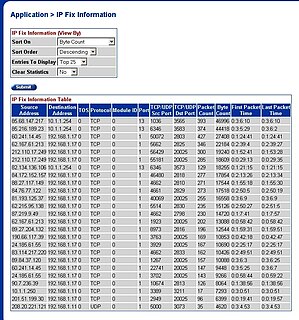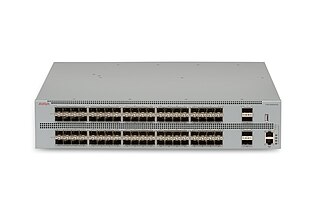
Carrier Routing System (CRS) is a modular and distributed core router developed by Cisco Systems Inc that enables service providers to deliver data, voice, and video services over a scalable IP Next-Generation Network (NGN) infrastructure. In a network topology, these routers are generally positioned in the core or edge of a service provider network. They are also used by Over-the-top content providers and large enterprises. It supports a wide range of interface speeds and types such as channelized OC3, OC12 to OC768 on Packet over SONET and from 1GE, 10GE all the way to 100GE on the Ethernet technologies. A standalone CRS-3 system can handle 2.2Tbit/s and a multi-chassis system could be designed to handle 322Tbit/s.
Riverstone Networks, was a provider of networking switching hardware based in Santa Clara, California. Originally part of Cabletron Systems, and based on an early acquisition of YAGO, it was one of the many Gigabit Ethernet startups in the mid-1990s. It is now a part of Alcatel-Lucent and its operations are being wound down via a Chapter 11 filing by their current owners.
PacketExchange was a British multinational network services provider based in London. Founded in 2002 by Jason Velody and Kieron O'Brien who were supported by Nigel Titley, Giles Heron, and Katie Snowball as the founder team, its network connected 45 points of presence across Europe, Asia and the United States over a private backbone consisting primarily of multiple 10 Gigabit Ethernet links over dedicated wavelengths on a fiber-optic mesh.
Provider Backbone Bridge Traffic Engineering (PBB-TE) is an approved telecommunications networking standard, IEEE 802.1Qay-2009. PBB-TE adapts Ethernet technology to carrier class transport networks. It is based on the layered VLAN tags and MAC-in-MAC encapsulation defined in IEEE 802.1ah, but it differs from PBB in eliminating flooding, dynamically created forwarding tables, and spanning tree protocols. Compared to PBB and its predecessors, PBB-TE behaves more predictably and its behavior can be more easily controlled by the network operator, at the expense of requiring up-front connection configuration at each bridge along a forwarding path. PBB-TE Operations, Administration, and Management (OAM) is usually based on IEEE 802.1ag. It was initially based on Nortel's Provider Backbone Transport (PBT).
Provider Backbone Bridges is a set of architecture and protocols for routing over a provider's network allowing interconnection of multiple Provider Bridge Networks without losing each customer's individually defined VLANs. It was initially created by Nortel before being submitted to the IEEE 802.1 committee for standardization. The final standard was approved by the IEEE in June 2008 as IEEE 802.1ah-2008 and has been integrated into IEEE 802.1Q-2011.

Allied Telesis is a network infrastructure/telecommunications company, formerly Allied Telesyn. Headquartered in Japan, their North American headquarters are in San Jose, California. Founded in 1987, the company is a global provider of secure Ethernet & IP access solutions and an industry leader in the deployment of IP triple play networks over copper and fiber access infrastructure.
Connection-oriented Ethernet refers to the transformation of Ethernet, a connectionless communication system by design, into a connection-oriented system. The aim of connection-oriented Ethernet is to create a networking technology that combines the flexibility and cost-efficiency of Ethernet with the reliability of connection-oriented protocols. Connection-oriented Ethernet is used in commercial carrier grade networks.

Multi-link trunking (MLT) is a link aggregation technology developed at Nortel in 1999. It allows grouping several physical Ethernet links into one logical Ethernet link to provide fault-tolerance and high-speed links between routers, switches, and servers.

The Avaya Ethernet Routing Switch 8600 or ERS 8600, previously known as the Passport 8600 or the Accelar 8000, is a modular chassis combination hardware router and switch used in computer networking. The system, originally designed and manufactured by Nortel, was manufactured by Avaya from 2009 until 2017. The system provided the 10G Ethernet equipment backbone for the 2010 Winter Olympics games, providing service for 15,000 VoIP Phones, 40,000 Ethernet connections and supporting 1.8 million live spectators. The system is configurable as a 1.440 Terabit Switch cluster using SMLT and R-SMLT protocols, to provide high reliability cluster failover.

The Ethernet Routing Switch 5500 Series or is a series of stackable, Layer 3 switches used in computer networking. The ERS 5000 was originally designed by Nortel and is now manufactured by Avaya. Up to 8 ERS 5000 Series Switches may be stacked in a 640 Gbit/s fast stacking configuration. This Switch was used as the access layer device for the 2010 Winter Olympics games. The 817 Access Switches supported 8782 Voice-over-IP telephones.
Juniper E-Series is a series of broadband services routers or edge routers manufactured by Juniper Networks. The E series was originally developed by Unisphere Networks, which Juniper acquired in 2002. These routers provide multiple services including broadband remote access server, broadband video services, dedicated access, 802.11 wireless subscriber management, VOIP, internet access, security services, network address translation (NAT) etc. on a single platform. The carrier-class architecture of E-series routers allows to combine Broadband Remote Access Server (B-RAS) and dedicated access capabilities on a single and integrated platform. The E-series routes runs on JUNOSe software compared to other series of routers of Juniper which runs on JUNOS.
On 12 April 2010, Hewlett-Packard completed a previously announced acquisition of 3Com. Following the HP acquisition, 3Com was fully absorbed by HP and no longer exists as a separate entity. The article below explains the portfolio at the time of acquisition.

Ethernet Routing Switch 5600 Series or in computer networking terms are stackable routers and switches designed and manufactured by Avaya. The ERS 5600 Switches can be stacked up to 8 units high to create a 1.152 Tbit/s backplane through the Flexible Advanced Stacking Technology (FAST) stacking technology configuration. The 5600 Series consists of five stackable models that can be mixed and matched together with other ERS 5600 models or other ERS 5500 models to meet configuration requirements. Additionally the ports on the switches incorporates the Avaya Energy Saver (AES) which can manage and dim down the power requirements to save energy across all switches in the enterprise.

Avaya Virtual Services Platform 9000 Series or VSP 9000 is a set of modular chassis switches used in enterprise and data center networks, manufactured by Avaya. The VSP 9000 is used by institutions which are suffering from performance limitations, need to simplify their network infrastructure in a virtualized environment, or require 10 Gigabit Ethernet today with the option to scale to 40 or 100 Gigabit Ethernet in the future. It is also an option for companies who are looking to reduce the power and cooling cost in order to maximize the cost-effectiveness of their infrastructures; this unit was also designed and is expected to have a lifespan of seven-to-ten years. In 2013 the Olympics network backbone is built with VSP 9000 Switches supporting 30,000 users and up to 54 terabits per second of traffic.
Avaya Ethernet Routing Switch 8800 Series or ERS 8800, is a range of modular chassis products that combine hardware router and switch used in computer networking, designed and manufactured by Avaya. When an ERS 8000 Chassis, a passive device in its own right, is equipped with the 8895 SF/CPU, this system is known as an Ethernet Routing Switch 8800; conversely, when equipped with an 8692 SF/CPU module the system is known as an Ethernet Routing Switch 8600.

The Dell blade server products are built around their M1000e enclosure that can hold their server blades, an embedded EqualLogic iSCSI storage area network and I/O modules including Ethernet, Fibre Channel and InfiniBand switches.
Avaya Virtual Services Platform 7000 Series or VSP 7000 is a set standalone/stackable switches, used in enterprise data networks, and data centers, manufactured by Avaya. This product is primarily offered to satisfy the Top-of-Rack (ToR) role for server farms and virtualized data centers. It supports Avaya's extended Shortest Path Bridging (SPB) implementation "Fabric Connect", and is future-ready for Edge Virtual Bridging (EVB) – IEEE 802.1Qbg, and Fiber Channel over Ethernet (FCoE). The system incorporates fifth generation application-specific integrated circuit (ASIC) chips with redundant and hot-swappable power supplies, fans, and expansion modules. The VSP 7000's unique architecture allows it to be meshed - fully or partially - with like devices, creating a high-capacity, low-latency network of up to 500 units, supporting up to 16,000 ports of 10GbE supported by a virtual backplane of up to 280Tbit/s
SwitchBlade is the registered name of a family of layer 2 and layer 3 chassis switches developed by Allied Telesis. Current models include the SwitchBlade x908 GEN2 modular switch and the SwitchBlade x8100 layer 3 chassis switches. The first model was the SwitchBlade 4000 layer 3 core chassis, which ran the earlier AlliedWare operating system.

The Avaya Virtual Services Platform 8000 Series, or VSP 8000, is a standalone Ethernet Switch, manufactured by Avaya and intended for use in Campus network and Data Center deployment scenarios.









